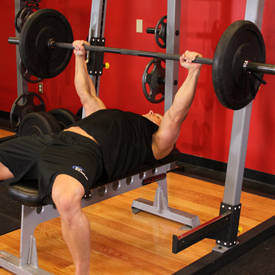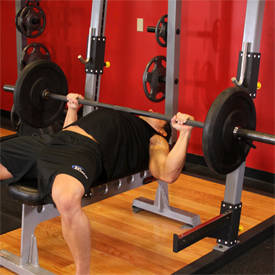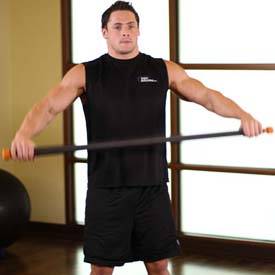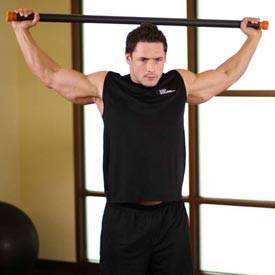You want pecs! You've done literally every exercise known to man to get your pecs to grow, but to no avail. You've begun to feel that you are doomed to a life without a well-developed chest; but there's still hope.
The chest muscles (mainly the Pectoralis major and Pectoralis minor) are involved in many shoulder movements, including lifting your arm in front of you (flexion), bringing your arms together in front of you (adduction) and turning your arms inwards (medial rotation). These are the movements you want to keep in mind whenever you are performing exercises such as bench presses, flyes, cable crossovers, pullovers, etc.


Bench Press - Medium Grip
What you may not understand is that chest exercises cannot work for you unless you know how to make the exercises work! You must work the muscles hard enough to create an overload in them, and they will adapt to this overload by becoming a bit bigger and stronger. If you do not work them hard enough, there will be no adaptation and you'll have no progress. If you work them too hard, the muscles will be breaking down more than repairing themselves, which will leave you smaller and weaker. You must constantly stay within the thin line between 'success' and 'failure' when it comes to training muscles properly, and the only way you can know what your limits are is by trial and error.
By constantly trying different techniques, you can get an idea as to how your body responds to them. There are many different training variations, which vary from person to person, but there are a few that could work for almost everybody. So here are five important principles that I have put together for the sole purpose of helping you get the mass and shape you desire in your chest muscles (Be sure to properly warm up your chest muscles and shoulder joints before starting):
1
Stretch
It seems that people tend to find this activity useless and boring, therefore skipping this part altogether when they are pressed for time. What they do not know is this can be one of the best and most enjoyable things to do in the long run. Keeping yourself limber is not only one of the best prevention methods against injuries such as pulled muscles or tendonitis, it is also a very good stress reliever when you are tense, as proper stretching tends to relax the tight muscles that are symptomatic of a stressed person.


Shoulder Stretch
Before and after working out: To warmup and increase the range of motion of the shoulder joint, and to regulate posture ( due to the chest muscles being tighter than the back muscles, therefore causing your body to 'hunch' forward). For warming up, the stretch can be held for around 10 seconds, whereas it should be held significantly longer in order to increase flexibility. Stay tuned for an article solely dedicated to the subject of stretching.
During a particular exercise: To increase the force of contraction of the pecs (You will actually feel the pectorals working more!). All this means is that you should be performing each exercise through the full range of motion in order to properly stretch the chest muscles. Probably one of the best chest exercises where you can feel a good stretch in the muscle is the flye. Keep in mind that in order to feel the increased muscle contraction, you must perform the flye movement in a somewhat smooth and controlled fashion. Please consult a qualified personal trainer if you are experiencing any difficulties with this technique.
2
Perform Movements Slowly
Paying special attention to the downward movement 'Negative' part of the movement. That's what is needed to put the proper load on your muscles. At too many times movements are performed too rapidly that instead of performing the work with the pectoral muscles, the weight is just being hoisted up and down using momentum; I'm sure moving a lot of weight very rapidly must be a great boost to someone's ego, but it doesn't do much for building a great chest (in fact you run a greater risk of hurting yourself, which can even further impede your goals of having a chest-of-steel).
3
Overload Your Muscles
You must work the muscles harder than they are used to working and then slowly increase the workload each time you go to the gym. (Warning - This might be painful). Progressive Resistance, as it is called, is what is needed in order to get the muscles to react by growing bigger and stronger. That is not to say that you should load up a bar with as much weight as you possibly can, that would be overdoing it. You only need to put on enough weight to fatigue the muscles, not destroy them!
4
Isometric Contractions
Isometric contractions are basically exercises where you are pushing against an immovable object (either a wall, table or even another bodypart).
Isometric contractions have been around for a long time and were made popular by Mr. Charles Atlas when he introduced his 'Dynamic Tension' program to the world. He claimed that we did not have to be a ninety-pound weakling getting sand kicked in our face anymore. He claimed that by following his exercise program we can be the ones kicking sand in ninety-pound weaklings' faces.
Isometric contractions have some good benefits, the main one being that you don't really need any equipment to get a full body workout.
These are very effective in 'finishing off' any chest exercise, and can even be performed at various times throughout the day, just to keep your pecs 'perky'. An example of and isometric exercise would be 'Palm Presses', where you press your palms together (with elbows up) as hard as you can, and hold the contraction anywhere from 10 to 30 seconds for maximum effectiveness.
There are a couple of setbacks to doing isometric exercises. The first one is that it can raise your blood pressure quite significantly because we have a tendency to hold our breath and perform a Valsalva manoeuvre (where you are trying to force out air with your windpipe being closed- kind of like trying to blow air into a balloon with a knot in it).
The second setback is that you have to take into consideration the full range of motion when doing a particular exercise. If you compare Palm Presses to the Bench Press, you would have to do palm presses with your hands directly in front of you, then maybe 3 inches apart, then 6, then 9, etc., until your arms are wide open, all in order to get the same benefit as the Bench Press. This is because when you do a Palm Press, you are only working the pecs in only one area (ie: when your palms are touching); when you do a Bench Press, however, you are working the pecs throughout the full range of motion of the exercise.
Despite these two setbacks, do not let it take away from the fact that isometric exercises are excellent for further working the pecs immediately after performing a set of bench press or flyes, etc.
5
Recuperate
This is where the active muscle growth takes place-so wait a day or two after a hard chest workout before training them again. (This of course depends on how many days a week you work out and how hard you work out).
